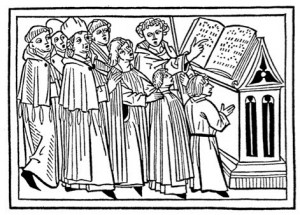From the Book of Sirach:
Then the singers praised [God] with their voices
in sweet and full-toned melody.
And the people of the Lord Most High offered
their prayers before the Merciful One,
until the order of worship of the Lord was ended,
and they completed his ritual.
(From the Daily Office Lectionary – Sirach 50:18-19 – November 9, 2012)
 Chapter 50 of Ben Sira’s book is a description of a temple liturgy led by “the high priest, Simon son of Onias.” (v. 1) It is filled with poured-out wine, sumptuous vestments, the shouting of priests, the blowing of trumpets, the people falling on their faces. Not the sort of ho-hum run-of-the-mill worship service one finds in most Christian churches these days.
Chapter 50 of Ben Sira’s book is a description of a temple liturgy led by “the high priest, Simon son of Onias.” (v. 1) It is filled with poured-out wine, sumptuous vestments, the shouting of priests, the blowing of trumpets, the people falling on their faces. Not the sort of ho-hum run-of-the-mill worship service one finds in most Christian churches these days.
A committee in my parish is studying the whys and wherefores of worship, what we do, how and why we do it, how we might do it better. Music, to which these verses briefly refer, has been an on-going topic of discussion. Tastes in music vary, emotions around music are passionate, commitments to one style or another are rock-solid.
“Open the gates of hell,” a clergy colleague once quipped, “and out will march an army of music directors!” I’ve never had any conflict with the music directors with whom I’ve served, but I know clergy who have. I’ve heard tales of such conflicts from both sides, from musician friends and from clergy colleagues. Battles between clergy and musicians are not uncommon. Battles between worship leaders and congregations about music are also not uncommon. Changing, or even supplementing, a congregation’s musical repertoire is something to be approached with fear and trembling.
The purpose of music in worship is to bring glory to God; therefore, the hymns the congregation sings, and the anthems the choirs prepare, should be centered on God, aesthetically pleasing, and thoughtful. The musicians and choristers should be technically competent and well-rehearsed. The chief instrument in the worship of God should be the human voice. It is the one instrument we have in common and it is capable of great beauty and resonance. But the use of musical instruments should not be shunned; the Scriptures are filled with references to trumpets and horns, stringed instruments, drums, and other instruments. These add beauty and diversity to our songs. The style of music or the type of instrumentation does not matter; vibrancy, depth, and quality of performance do (at least for the anthems or other “performance pieces” that may be offered). For songs with words, whether performed by the choir or sung by the congregation, the theological content of the lyrics should also be of concern.
Some congregations are great at singing hymns; in other churches, only a few people dare to open their mouths. This is a great sadness. Everyone has a voice that was given them by God and God expects that voice to be used. In a former parish, we hung a sign in our entryway – “If you can’t sing good, sing loud!” – we invited everyone to sing. Whatever flaws our individual voices may have, when they are raised together in song those flaws disappear. When the Body of Christ sings, when every voice is lifted, the effect is wonderful and, I’m sure, pleasing to God. St. Augustine of Hippo is often quoted as having said “He who sings, prays twice.” Singing is much to be encouraged.
So, as that great and wonderful hymn by James Weldon Johnson says, “lift every voice and sing ’til earth and heaven ring!”
====================
A request to my readers: I’m trying to build the readership of this blog and I’d very much appreciate your help in doing so. If you find something here that is of value, please share it with others. If you are on Facebook, “like” the posts on your page so others can see them. If you are following me on Twitter, please “retweet” the notices of these meditations. If you have a blog of your own, please include mine in your links (a favor I will gladly reciprocate). Many thanks!
====================
Father Funston is the rector of St. Paul’s Episcopal Church, Medina, Ohio.



Leave a Reply